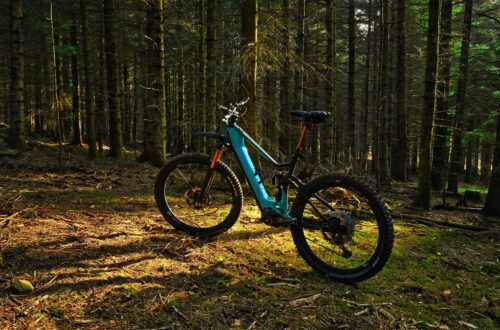
The Impact Of eMTB Tuning: My Personal Story
When I got my first eMTB a few years ago, I felt like the speed limiter was holding me back from using my bike the way I want. Removing the speed limiter was an option, but that doesn’t come without consequences. Would it damage my motor and battery?
Although many advised against tuning, I decided to go for it. Three years and 10.000 km or 6200 miles later, I decided to document my experience for anyone that’s curious to find out about the impact of eMTB tuning. Maybe you can learn from my mistakes!
Reasons For Me To Tune My eMTB
As mentioned in the intro, the speed limiter prevented me from using the bike’s full potential. The speed limit for pedelecs in Europe, is 25 km/h or 15.5 mph. Although that’s sufficient for most circumstances, I felt like the bike was holding me back in the faster sections.
After doing some thorough research on the consequences of removing the speed limiter, I knew that I had to make some concessions:
- I’m not allowed to ride my derestricted bike on the public road
- I can’t make use of the manufacturer’s warranty, as it’s immediately void
- Removing the speed limiter may have an impact on the lifespan of my bike
How I Tuned My eMTB
There are various ways to remove the speed limiter of an e-bike. You can go for an externally mounted tuning device that often doesn’t require any tools to fit. Alternatively, you can opt for a tuning dongle that actually plugs into your system, but is a bit more difficult to fit. On some e-bikes, you can even alter the software to increase the speed limiter, but that’s not something most people can do themselves.
In the next section, we’ll discuss the tuning device that I went for
The Best Tuning Device For Me
First of all, I own a 2021 Trek Rail 5 with a 625 Wh battery. In my search for the best tuning device for me, I listed a few requirements:
- Has to be durable
- Speed and mileage reading must be correct
- Preferably invisible
- Can be switched on and off
Based on these requirements, the best solution would be an internally mounted device such as a dongle. For the Bosch Performance Line CX Gen4, the most commonly used dongles are from Volspeed, Speedbox and Bikespeed.
Although these dongles are quite similar, I went for the Bikespeed-RS. After reading some reviews, I found that many people had a positive experience with this device in combination with the Performance Line CX.
The Bikespeed-RS is simple to use and well built. To turn it on or off, you just have to press a button sequence on your display. Other than that, you hardly notice it’s there. If you want your dongle to be customizable, you can go for the Bikespeed-RSc. In my case, the basic version does exactly what want.
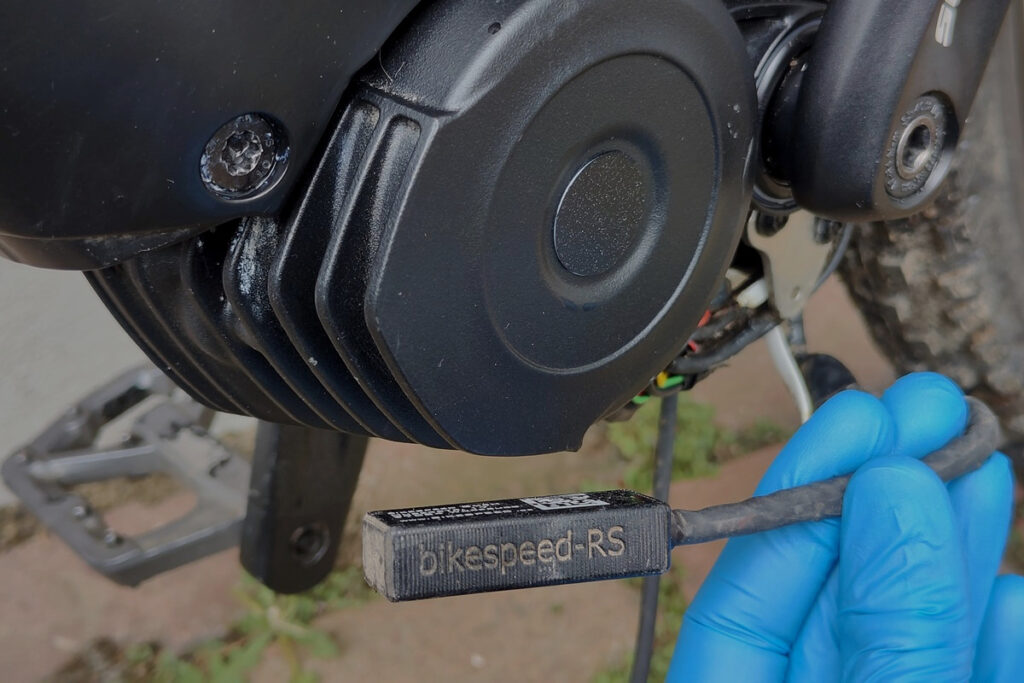
Some tuning devices require you to leave your bike ‘on’ after each ride for a certain amount of time. This procedure must be followed otherwise you might get an error code. The Bikespeed-RS doesn’t require you to do this, so you can turn your bike off as normal. It also shows the right speed and mileage at all times!
Software Version And Updates
Error codes are still a big concern when it comes to tuning. As manufacturers try to put a stop to tuning, tuning companies try to find a workaround. The software on your bike is able to detect whether your bike has been tuned. Therefore, there’s no guarantee that your bike will never throw an error code, even though on paper, the device should work with your motor/display.
Errors codes can be a pain as they have consequences. With Bosch motors for example, the bike will go into an emergency mode with limited assist. After 90 minutes of peddling, the issue will resolve itself. But after three times, you have to take your bike to the dealer to deactivate the limp mode.
To reduce the chance of an error, it’s important to check whether the tuning device that you intend to buy, is compatible with your bike. Also do this if you’ve purchased your bike second-hand. Most tuning companies display the compatible software versions on their website.
On my 2021 Trek Rail 5, I have the following hardware/software. The software-versions are still from 2021, because I haven’t updated my bike since. The Bikespeed-RS works perfectly with this set-up:
- Bosch Purion display: V1.4.0.0
- Bosch Performance Line CX Gen4 motor: V1.1.5.0
- Bosch PowerTube 625 Wh battery: V1.10.8.0
After successfully installing a tuning device, it’s important to never update your bike. The tuning might no longer work after the update.
The Installation Procedure
The installation procedure can be a bit fiddly, but if done right, you never have to look at it again. It depends on the bike and drive-unit how hard a tuning dongle is to fit. Let’s go through the procedure.
The Bikespeed-RS comes with 4 connectors attached. It basically intercepts two cables (the controller and rear speed sensor cable) before they go into your motor. You don’t have to cut any wires.
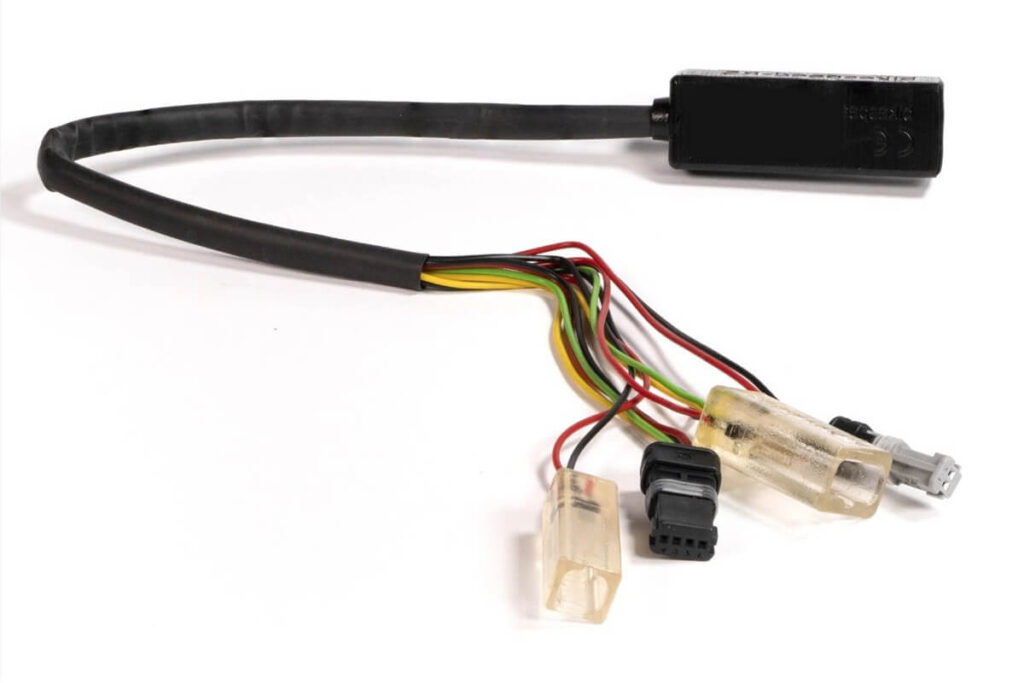
To start off, you need to remove the skidplate in order to get to the connectors. In my case, this is just a protective skidplate that runs underneath the motor. Some drive units may require you to remove one crank arm in order to remove the motor cover.
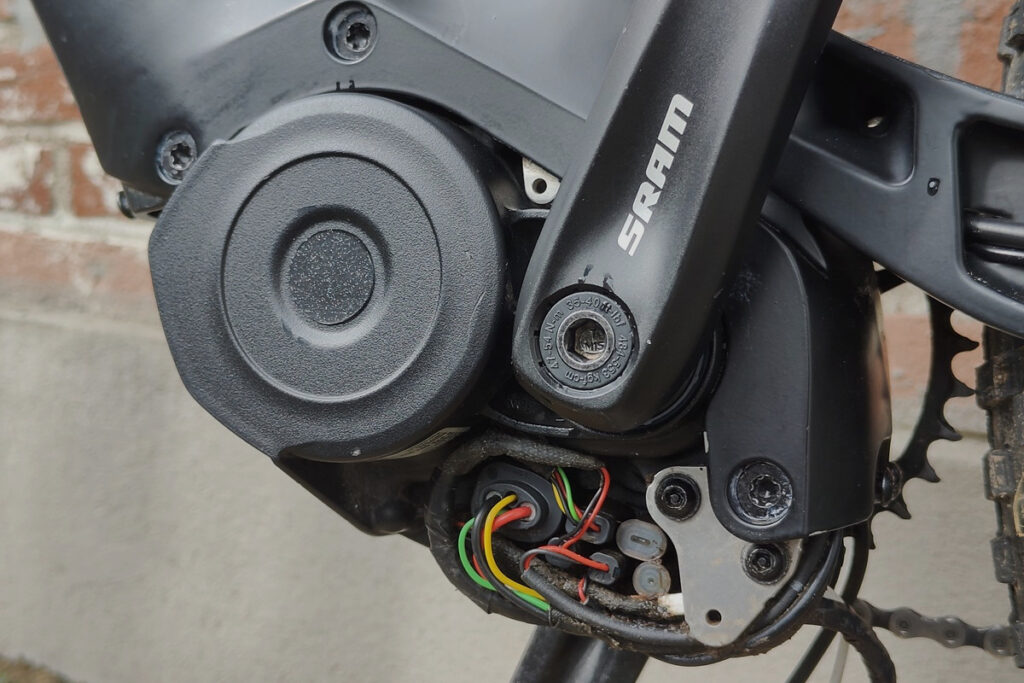
Once the skidplate has been removed, you unplug 2 connectors: the controller and rear speed sensor cable connector. The right connectors can easily be identified if you compare the connectors of the tuning dongle with the ones on your bike. You really can’t get it wrong, but you have to be careful to not damage one of the connectors.
Now it’s time to plug the Bikespeed-RS in to your motor. The connectors that you’ve previously taken out of the motor, you now plug in to the dongle.
It’s key to find a place for the dongle and cables to sit comfortably. If you don’t do this properly, the cables can get squished between the motor and casing, causing your bike to malfunction. In my case, I was able to push the tuning dongle inside my downtube, and the cables between the cooling ribs on my drive.
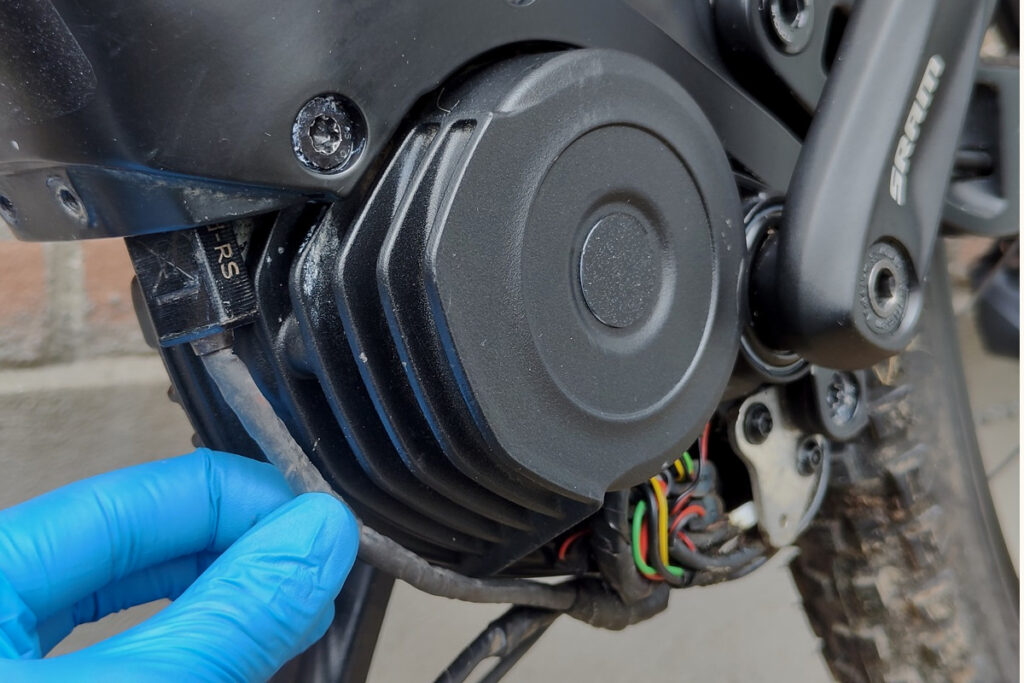
To last step is to re-install the skidplate. It’s important that the plate goes on without much resistance. Carefully keep an eye on where the cables go.
All in all, I found the installation process quite easy.
My First Impression
The first time riding my derestricted eMTB was awesome. I felt like I could finally use the full bike’s potential. What struck me, was that the power delivery feels completely natural. As if the bike came out of the factory like this.
To find out how fast my bike could actually go, I gave it a try on a private road. With a 34T front chainring in the front and an 11T cog on my cassette, I achieved a top speed of 55 km/h or 34 mph! I had however reached my maximum cadence, so I couldn’t peddle any faster.
On a smooth and flat surface, I found 32 km/h or 20 mph to be a comfortable speed to peddle. It just suits the original gearing of the bike very well. Ironically, 20 mph is also the speed limit for pedelecs in the US, Canada and New Zealand. But unfortunately, I guess we can’t have it all…
On mountain bike trails, I found that I rarely reached speeds above the original speed limiter. It was only in the high speeds section where I could really benefit from riding a derestricted bike.
Overall, my first impressions was very positive! I haven’t experienced any issues.
My Impression After 10.000 km/6200 miles
Over a period of three years, I’ve ridden my derestricted eMTB 10.000 km or 6200 miles. In the next section, we’ll go through my experience and some issues I encountered.
Electrical Issues
First of all, my bike is still going strong. I had however two minor electrical issues.
The first one was error code ‘414’ on my display. This turned out to be a connection issue with the display. The good old ‘turn it off and back on again’, solved the issue and it never came back. In my three years of ownership, I never received an error-code that could be related to tuning, like ‘504’ or ‘524’.
The second issue was due to my own fault. In the aforementioned installation procedure, I talked about the importance of finding a suitable place for the dongle and cables to sit comfortably. What you don’t want, is for the wires to get squished between the skidplate and motor housing.
When my skidplate took a serious hit, the above happened. There was a cable breakage and the system shut down completely. I had to ride home without any assistance. Luckily, I was able to repair the breakage at home. The dongle now sits comfortably inside my downtube.
Motor And Battery Issues
The motor and battery were my biggest concern when I was considering e-bike tuning. Mostly because the dealer told me that removing the speed limiter would cause these components to fail. Which I think is a bit short-sighted, but I understand that they don’t want anything to do with tuning.
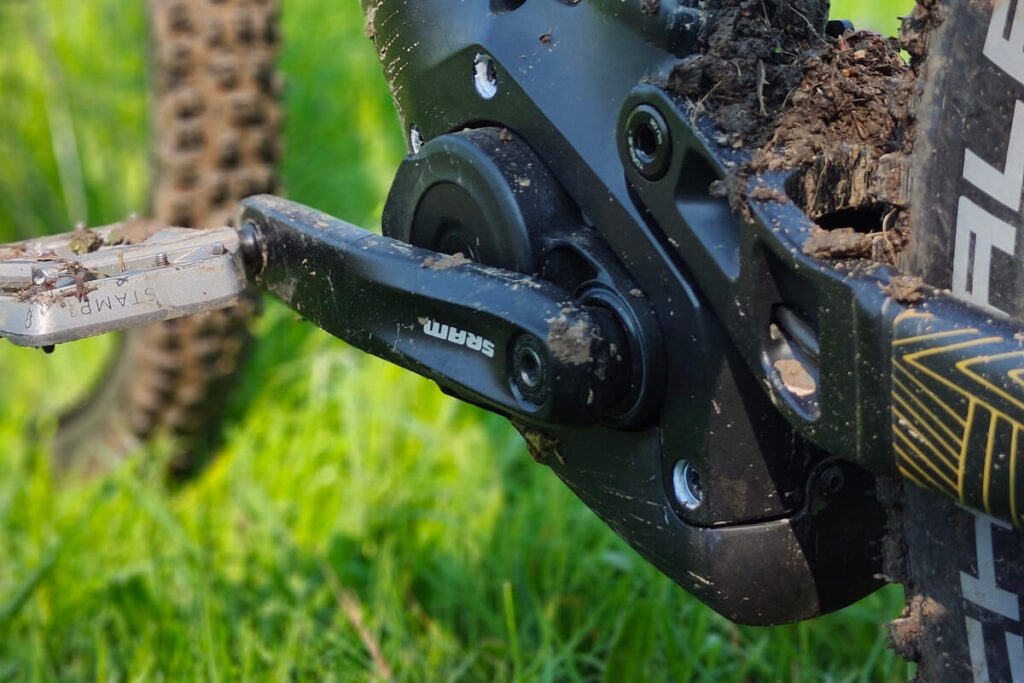
During those three years of riding derestricted, I haven’t experienced any issues with the motor or battery. The battery stills gives me the same range as when it was new. On average, I ride 2 times a week and I charge it after every ride. This translates to around 300 charging cycles.
The motor also still operates as normal. The power delivery is strong, smooth and I haven’t experienced any change in noise. I check my crank for play quite regularly.
Increased Wear And Tear
If you often ride your bike fast, you’ll notice an increase of wear of your drivetrain (cassette, chain and chainring) and brakes. Fundamentally, an increase of speed, also increases the load which has an impact on every component of your bike. Think of your wheels, suspension and frame.
To be honest, I’m not in the best position to make any statements about this, as this is my first eMTB and I derestricted it right away. I therefore don’t really have a before and after comparison. Changing chains, cassettes and chainrings regularly, is all part of owning an eMTB. There’s a reason why manufacturers are now starting to use a motor and gearbox in one unit like the Pinion E1.12…
What I can tell you about wear and tear of the drivetrain, is that the smaller cogs on my cassette wear particularly fast. From what I’ve heard from the dealer, this is a common occurrence on an eMTB, let alone on a derestricted bike. Which makes sense because at higher speeds, you’re relying more on cogs with fewer teeth on an already quite weak drivetrain. My first cassette lasted about 800 km or 500 miles. Nowadays, I get about 2500 km or 1550 miles out of one cassette.
A trick that I’ve found to save some money on expensive new cassettes, is to only replace the smaller cogs when the rest of the cassette is still good. For the Sram PG 1210/1230 Eagle cassettes, Sram sells the 11T, 13T and 15T cog as a set separately. Only replace these in combination with a new chain and regularly use a chain checker!
I personally haven’t experienced any issues with other components of my bike. It very much depends on your riding style and where you ride.
Legal Issues
It’s illegal to use a derestricted e-bike on the public road. Because since I still want to enjoy a tuned e-bike, I only use my bike on private land and in bike parks with permission of the owner.
To get there, I transport my bike with my car. Whenever I have to use my bike on the public road, I remove the tuning dongle. I could alternatively just turn it off, but I don’t want to get into any legal problems just because the device is present.
Learn more about the legal consequences of riding a derestricted bike on the public road, here.
Warranty Claims
My 2021 Trek Rail 5 came with a 2-year manufacturer’s warranty. I derestricted my bike after only a few months, so the warranty was almost immediately void.
During those first 2-years, I haven’t experienced any issues that would have otherwise made a valid warranty claim. But because I was lucky doesn’t mean you will be too.
If you are thinking about derestricting an eMTB that’s still within its warranty period, it’s important to you are able and willing to take responsibility for any issues that may occur within that period. There’s also no point in lying about it to your dealer. A diagnose of the system will always show whether the bike has been tampered with, even if you’ve removed the tuning device.
If you ever take your derestricted bike to the dealer, I advise you to just be open and transparent about it. They will be more likely to help you if you’re honest.
Some Final Thoughts
My experience with e-bike tuning has been positive as I haven’t experienced any issues. However, I do want to share some final thoughts.
The fact that my bike has been faultless, is in my opinion, mainly due to how I use my bike. Fundamentally it isn’t harmful for your bike to remove the speed limiter, but riding fast for a long time is. If you were to use your bike as a commuter for example, your motor will run at high power for a longer period of time, causing the temperature of your battery to rise. In the long run, you can then expect a shortened lifespan of those components.
Another reason why I believe tuning doesn’t have a significant impact on my eMTB, is because the speed limit for pedelecs is higher in some parts of the world (20 mph). And although the speed limit is different, the hardware isn’t. From this we can conclude that the motor and battery are designed to operate at a higher speed.
What I do want to add, is that I’m very meticulous when it comes to keeping water out of my motor. Water ingress is one of the leading causes of e-bike motor failures. I therefore advise you to never point a pressure washer directly at your motor. If you want more tips on how to clean an eMTB properly, you should read this article.
And lastly, I want to give you some food for thought when it comes to using a derestricted eMTB on the public road. Many people don’t know even half of the (legal) consequences of getting into an accident. Your decision to tune your bike, does not only affect you, but also the people around you. Also consider your role in maintaining the rules and regulations surrounding pedelecs.
If you want to derestrict your eMTB but you also need your bike to be road legal, then an externally mounted device like the Badassbox might be the right solution for you. You can easily remove it when you don’t want to use it.
I plan on keeping my derestricted for a few more years, and will update this article regularly!


